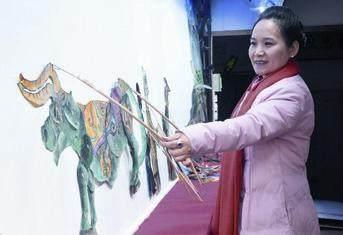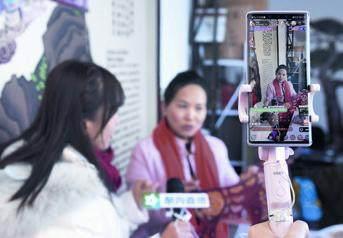Stepping Out of The Shadows
By Deng Di
The sounds of gongs and drums fade into the background as figurines made from animal skins suddenly come to life behind a screen, spinning and jumping, telling children’s stories or grown-up tales of love and hate; call it a movie projection avant la lettre. The audience is enthralled and everything around them is immersed in this ancient art of shadow.
Two thousand years ago, the sadness of Emperor Wu of the Western Han Dynasty (202 B.C.-A.D. 25) over the death of his favorite concubine was somewhat alleviated by the projection of her figure through a game of lights. This started what is now known in China as the earliest form of shadow play.
This intangible heritage of the nation is a traditional art recognized by UNESCO and a cultural treasure of the world. Puppetry seems to feature only simple accessories, but in fact combines performance, modeling, carving and color matching. One shadow play performer can tell thousands of years’worth of stories; both hands can operate many characters.
Shadow theater is a unique art form in China and a type of opera. Thanks to the basic principle of light and shadow projected onto a screen and figures carved and painted using the skins of cows, donkeys, horses or sheep, the performers use these puppets to tell various stories in a form of scenic art typical of opera. Rooted in China’s northwestern Shaanxi Province during the Western Han, it is considered the oldest active cinematographic art in the world adopted by humans. There are those who refer to shadow theater as the ancestor of modern cinematography.
Among all the country’s branches, Beijing shadow theater stands out for its techniques in carving and modeling the puppets, as well as its specific tunes. Initially, Beijing puppetry panache was divided into two schools: east and west. The eastern school disappeared very early on, while the western school came into being during the Ming Dynasty (1368-1644). In 1842, Lu Decheng inherited this art and established the Beijing Xiangshun Shadow Theater. Since then, the art of Beijing western-school shadow theater has been passed down generations of the Lu family.

Beijing shadow puppetry has undergone a long period of formation and features unique performance methods. Its vocal tone draws inspiration from the melodies of Kunqu Opera, Peking Opera, and quyi—folk art that includes narration accompanied by drums and the occasional comedic note. As for the actual puppets, they are based on Peking Opera.
The creation of the puppets involves several processes, such as material selection, carving, painting, sewing and inking. Two tools prove indispensable throughout: the wax board and the carving knife.
The board is crafted from yellow wax, butter and spices. After cooking the three materials, they are placed inside a metal or wooden container. The most important feature of the wax board is its resilience. After thousands of knife engravings, its original shape can be restored simply by pressing it with the flat side of a small, hard knife. Wellpreserved wax tablets can be handed down through generations.
The carving knife is the main instrument for crafting puppet silhouettes. Before, craftsmen used wooden knives; today, there are many alternatives. No matter how complicated the puppet figures are, a carving knife and a wax board are enough to produce a play, though auxiliary tools such as scissors may come in handy.
Once the carving is completed, the artisan will coat the semi-transparent leather with a brush and watercolor paint. The mingling of color combinations and patterns put to the test any artisanal skillset, as the shadow plays must guarantee the integrity of the colors and drawings. The last step is to bind together all the different parts with thread and mount them on a thin stick. Et voilà, one finished figurine.
For a puppet to be considered exquisite, even their strands of hair or beards must be life-like. They do not only serve the stage but can also spruce up the home decor.

In the past, the shadow theater was performed in the fields, with all performers hidden behind the scenes; some manipulated the puppets and sang, while others managed the music. A troupe would consist of six or seven people and a box of puppets. When putting on a play at a market or square, the installation of light boxes and curtains would suffice to start the show. Requiring only the bare minimum, the theater was characterized by its mobility, often making a welcome appearance at weddings, banquets and Chinese New Year celebrations. A troupe could perform up to 30 or 40 times a day, well into the night at times, and when the curtain fell, the performers would pack up shop and move on.
Lu Baogang, head of the Beijing Shadow Theater Ensemble, is the representative inheritor as well as the fifth-generation inheritor of the Lu family’s Beijing western-school shadow puppetry.
Talking about the art, Lu explained there are many more genres on the Chinese stage. At present, more than 50 percent of them hail from Shaanxi, while 30 to 40 percent come from northern Hebei Province. However, there are few shadow performances in Beijing due to insufficient development. “As an heir to this art, I have a responsibility to tell the younger generations about its true meaning so that they can continue the legacy. Only this way will shadow theater in Beijing stand the test of time,” he explained.
Given today’s explosion in entertainment forms, the art has somewhat“recoiled” into the shadows. Right now, the country has only a little more than 10 theater puppet play groups that are regularly active. In view of the retirement and death of many artists of the older generation, and in spite of Lu’s endeavors, the capital’s typical puppetry has come to a standstill.
The Beijing Shadow Theater Ensemble struggled to the point where it no longer had its own performance venue, and the actors’ income was very low. The art’s evaporation became a relentless threat. To solve this problem, Lu and his colleagues began seeking active collaborations with forms of entertainment that are of popular interest. It’s time to raise the curtain once again. BR

